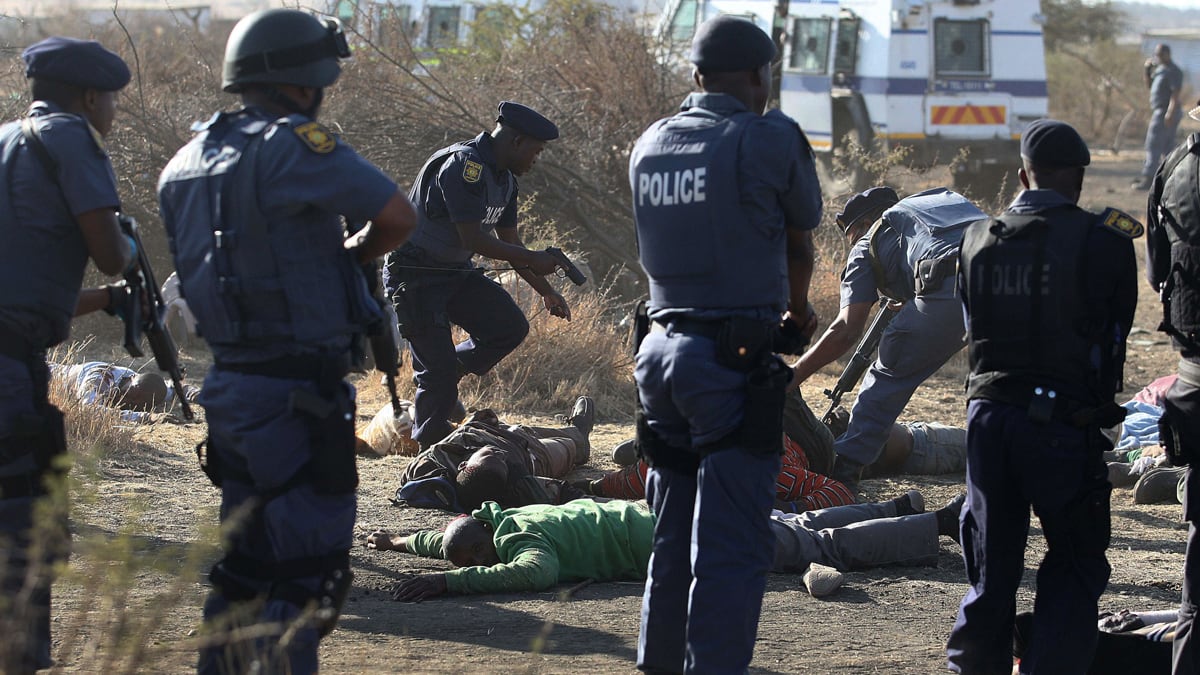by Aislinn Laing
Striking miners shot dead by police at South Africa's Lonmin mine were reportedly hit in the back, suggesting they were fleeing rather than attacking.
Postmortem examinations revealed that most of the 34 victims of the police action on Aug.16 were shot in the back, while a smaller number were shot while facing forward, Johannesburg's Star newspaper reported, citing sources close to the investigation.
If proved correct, the leaked results could contradict police claims that they only opened fire after being fired upon.
Those working to keep the peace in the northwestern town of Marikana, where the Lonmin platinum mine is situated, said they feared that the report could inflame tensions further in the still febrile atmosphere.
More than 150 complaints have been filed with the Independent Police Investigative Directorate over the alleged torture and assault in police custody of miners who were arrested following the violence.
On Monday, London-listed Lonmin said that just 13 percent of its 28,000 workers arrived for their shifts, following intimidation of bus drivers and other workers by groups of men issuing threats of "repercussions" if they clocked in.

The company is now relying on a "peace accord" meeting planned for Wednesday with the unions, brokered by the Department of Labour. "Everyone must buy into the peace accord before any discussions on issues such as wages can take place," said Sue Vey, a Lonmin spokesman.
Around 3,000 specialist rock-drillers are on strike, backed by the militant Association of Mineworkers and Construction Union (AMCU), pushing for a massive wage increase.
The strike began on Aug. 10 and saw 10 killed—including two police officers and mine security staff—within days. On Aug. 16, following fruitless attempts to control the crowd with tear gas, barbed wire, and water cannons, police hit back in a three-minute live fire barrage that constituted the deadliest force used since the end of apartheid in 1994.
In a press conference shortly after the incident, Gen. Riah Phiyega, the national police commissioner, said she authorized the use of live ammunition because she was told police had come under attack from the striking workers.
"The militant group stormed towards the police firing shots and wielding dangerous weapons," she said.
The government confirmed on Friday that postmortems conducted by state pathologists and verified by independent private pathologists had been completed.
But it remains unclear who has seen the results of the examinations. Harold Maloka, a spokesman for the Inter-Ministerial Committee set up by government to handle the crisis, said they would be released as part of the public inquiry into what happened, which is due to report back in four months.
The Star newspaper claimed it had spoken to several sources close to the investigation and with knowledge of the results.
"The postmortem reports indicate that most of the people were fleeing from the police when they got killed," it quoted one unnamed source as saying.
"A lot of them were shot in the back and the bullets exited through their chests. Only a few people were found to be shot from the front."
Zweli Mnisi, spokesman for Police Minister Nathi Mehethwa, condemned the report as "irresponsible."
"Before the public know these results, the families must first know and not read about it in the newspapers," he said. "We call on all parties to exercise cautions—these are people's lives we are talking about."
Kevin Dowling, the bishop of nearby Rustenburg who is among a large contingent of churchmen working in Marikana, called for clear leadership from the mine managers, unions, politicians, and mediators to prevent further violence.
"Unless there is proactive action by all stakeholders to influence the situation positively and stabilize it, there could be more outbreaks of unrest when rumors go round and news like this gets out," he said.
"There is still a lot of very deep emotion in operation here and this just may inflame emotions higher."

